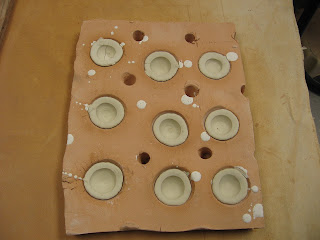New Jars
I have some new ceramic jars that I'd like to display here. I also have some jars at Oak Hollow Gallery right now, and I am trying to get a dozen or so ahead for the spring Larson Gallery Artists home show. So let's get started.
This is a large smoke fired olla, probably constructed from Dakota Red clay, burnished and relatively naked (no stains or slips).
Next a traditional Olla with landscape panels and some neck decoration. That landscape derived from some sketches I made of Umptanum Ridge, west of the Yakima River.
and one that is a bit more/less traditional. This jar has about all the features I look for in a large jar, including, "not so big".
I have been ask about my inspiration, so here is a sample of the things that inspire my jars. This painting is by Kate Cartwright, pretty cool, hunah...
Somehow, that seemingly out of place b/w square in the upper middle is the key to this piece,,,but wait, can you find the missing square?? and where the heck is the artists signature?
This jar is relatively new. I like the crackle and the finish of this smoke fired piece. I call it, "Pouring Jar" because it's smooched on top to make it easy to pour liquids. Burnt Umber is responsible for some of the brown in this jar.
And next a jar that was fired in the same smoke fired kiln (at the same time) is somewhat similar but a lot different. Because of the low fire Temmoku appearing glaze I call it "Ancient jar". You get the idea even if it's only a week old:
About time for a poem. This one will appear someday in the "Listos" collection. It's along the same theme as the jar above.
Campos
Triste
These are the ancient times
and all of my friends have faded
into oblivion.
I hear the seagull cry against
the pounding surf
that kept us awake at Rhodes,
after a cup of hard Coffee
and an aperitif with Baudelaire,
before they swept the café clean
and turned out the lights on our
wordless path.
Those lazy café waiters
and the Campaneros of Rios
called to me a greeting in the
hushed dawn
where a small child carried my
satchel
up the hill for a few
pennys.
The Campos and the Campos Poets
now puzzle over my small verse
before they are conquered by
dust,
and your bare shoulder exposed
in the darkened room
turns again before disappearing
forever
from this moment.
And to you,
in whose favor we met so many
promises,
and from whom I know only myself
(in this bright tradition of
days)
will yet see my form, still and
lifeless,
on the battlefield
we once called Time./mh.
---------------
Enough of the text already. Let's look at another jar. I did this one in the Spring of 2013 and I think I sold it in the spring Yakima Art Fest. That or I've just lost track of it.
Which takes care of some of my recent jars. But let's drop back and see from where these jars came. They all start out as red clay jars, much like a painter starts with a prepared canvas. You may not even recognize these "Dakota Red" jars because in the next few weeks they will go through great changes to become the pots they are destined to be. These jars are sitting on a slab roller, and the guitar on the left is addressed in a much earlier post. Usually I look at my jars for a few weeks and then one morning grab one and slap some glaze on it and/or throw it in a smoke barrell?
One more photo and then we'll call it quits for a few days. This piece of iron below sits in my studio. I bought it from my old mentor packer, Bill Rennie. He had it in his storage shed in gleed and wanted to get rid of it so I think I gave him $5 bucks, but then, that was almost 30 years ago. $5 for a piece of iron,,, Well, it's a very useful piece of iron!!!
I usually make a promise at the end of each post, telling anyone who accidently hits this site what i'm planning to do in the next post. Then I promptly forget what I said and instead, don't do a new post for a month or so. In that case, I'll post something tomorrow about Milk Weed seed, or, as my milk weed buddies say,
"Ogala".






























